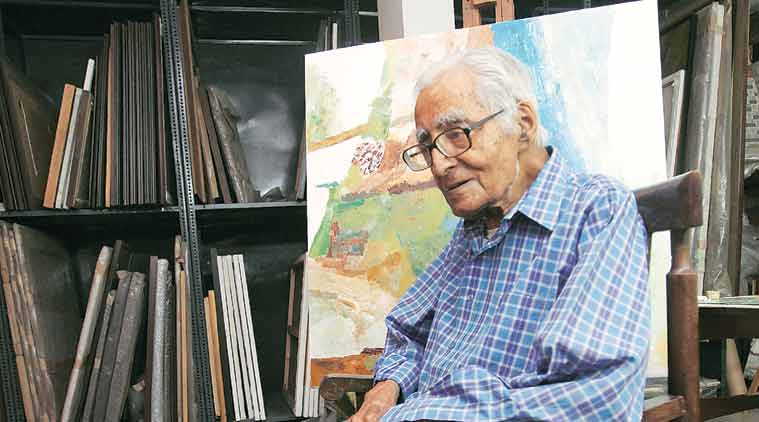The passing away of abstract painter and writer Ramkumar at the age of 94 has removed from our midst one of India’s most celebrated artists. Ramkumar was a part of the ‘Progressive Artists Group’ that proudly held the banner of Indian art aloft in the international firmament. The other members of the group were the late M.F. Husain, the late Tyeb Mehta, and the late S.H. Raza, all painters of national and international repute.
Ramkumar’s works too were valued highly in the international market, and his canvases sold for crores of rupees. One of his works ‘The Vagabond’, was auctioned by Christies for a phenomenal amount of $ 1.1 million. Ramkumar was born in Shimla on 23 September 1924. His first brush with art came when he was undergoing his post graduate course in Economics, and he chanced to visit an exhibition of art which had paintings by the masters of the time. The exhibition interested him a lot, and he made it a point to visit it repeatedly and imbibe the nuances of the art on display. After finishing his education he landed a lucrative bank job, but later relinquished it in favour of art. He also had a short stint as a journalist with a Delhi newspaper. He initially picked up the rudiments of art from Saillos Mukerjee, and mastered still life using models as props. It was during that time that he met another renowned abstract painter S.H. Raza, and a bond of kinship blossomed between the duo that was to last their lifetime.
Ramkumar made an extended trip to Paris, then the Mecca of modern art, with the sole purpose of pursuing art. His teachers in Paris were acclaimed painters Andre Lohte and Fernand Lager. After a good grounding in art in the French capital, he returned to India and pursued his career as a full time artist and painter. With time he mastered the medium and was equally comfortable with oils and acrylic. He also gave up figurative art for abstract and later concentrated on it and his efforts to scale up the ladder were highly successful.
Ramkumar was hailed as a modernist master, and was an integral part of several arts exhibitions and biennales across the world. Among the major exhibitions in which the artist participated was the 1958 biennale in Venice, and the Festival of India shows held in the then USSR and Japan. His last solo exhibition was held at Delhi in 2008. Most of Ramkumar’s early works centred around the squalid living conditions in and around cities like Varanasi, the dilapidated buildings, crammed houses, and so on. Varanasi remained a recurring leitmotif in his paintings and he went on to paint the city in different conditions and lights. Ramkumar also excelled in paintings of glistening glaciers, flowing rivers and other panoramic vignettes from nature’s bounty.
The artist was also an accomplished writer as well and wrote extensively in Hindi. Eight collections of his works have been published and among these were a couple of novels and a travelogue. Although he did not achieve the level of success of his sibling, the celebrated Hindi writer Nirmal Verma, as writing was not his main preoccupation, Ramkumar’s books too were quite popular with the readers with the book The Face and other stories being well received.
Ramkumar received a number of honours in his lifetime, and these included inter alia, the Kalidas Samman from the Government of Madhya Pradesh, and a Lifetime Achievement Award from the Government of Delhi. The Lalit Kala Academy too awarded him a Fellowship. He was also a recipient of the prestigious John D. Rockfeller Fellowship from New York, USA. The Government of India conferred on the artist the Padma Shri in 1972, and the Padma Bhushan in 2010. The distinguished artist and man of letters passed away in Delhi on 14 April 2018. Rich tributes were paid to his memory by fellow artists, and art connoisseurs across the world as well.


 [/column]
[/column]